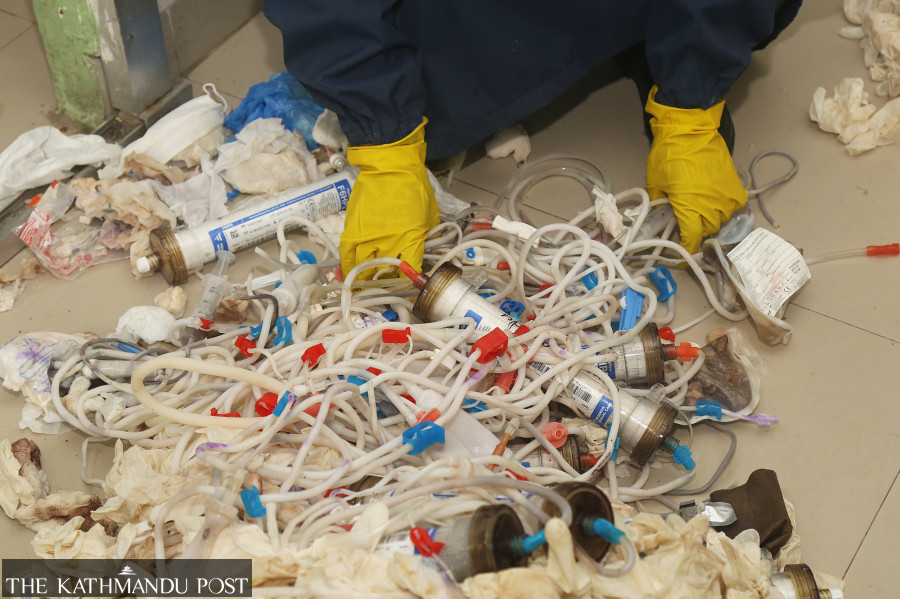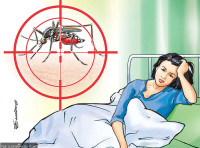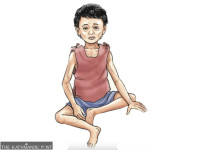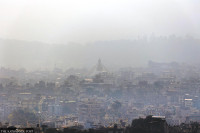Health
Nepal’s health sector produces 4.1 percent of national greenhouse gas emissions: Report
The practice of burning medical waste at healthcare facilities is widespread, and they often mix hazardous medical waste with regular waste, study shows.
Post Report
When researchers saw the incineration of hazardous clinical waste materials at the Tribhuvan University Teaching Hospital, they were shocked to find that the incinerator, designed to burn hazardous materials at high temperatures to destroy contaminants, was being used only as a burning chamber.
“Problems with hazardous and clinical waste burning are not limited to the Tribhuvan University Teaching Hospital, but they are common in almost all hospitals across the country,” said Bhupendra Das, an air quality specialist. “Burning hazardous healthcare waste haphazardly also contributes to greenhouse gas emissions.”
A recent study titled “Baseline Assessment of GHG Emission of Nepal’s Health Sector,” a nationwide survey carried out by the World Health Organisation for the Ministry of Health and Population shows that Nepal’s healthcare sector is responsible for 4.1 percent of the country’s total greenhouse gas emissions.
According to the report, improper incineration of waste materials is among the chief contributors to greenhouse emissions.
“Indirect sources—business trips, employee computing, patient commuting, inhalers, extra supply chain, electricity transmission and distribution losses, and off-site waste contributed to maximum greenhouse emission,” the report stated. “This is followed by direct emissions—stationary combustion, mobile combustion, fugitive emissions, on-site waste, and purchased electricity.”
Experts say burning medical waste is particularly harmful as it can produce dioxins, furans, and other hazardous chemicals, which can even cause cancer. Pathological waste contains harmful microorganisms—bacteria and viruses—which can easily spread infections if not managed properly.
Das, who is also the study's principal investigator, recommends various measures for reducing emissions—replacing inefficient incinerators with energy-efficient stationary combustion appliances, constructing waste recycling facilities, and using non-burn technologies, among others.
Hospital waste management is an important but neglected issue in Nepal. Most healthcare facilities—hospitals, nursing homes, polyclinics, laboratories, and state-run health centres—do not have their own incinerators and they discard hazardous medical waste by mixing it with household waste. As a result, cleaning staff, waste collectors, and ragpickers, among others, are at risk of getting injured or infected from needles and other hazardous medical waste.
Doctors warn that mixing hazardous waste with household waste increases the risk of spreading infections such as HIV, Hepatitis B, Hepatitis C, tuberculosis, tetanus, and coronavirus.
A report published by the Ministry of Health and Population in 2020 showed that the practice of burning, burying and disposing of hazardous immunisation waste and mixing with municipal waste by private hospitals was widespread.
The study titled, “Assessment of Immunisation Services in the Private Sector in Kathmandu Valley,” carried out by a consortium of [US] Atlanta’s Center for Disease Control and Prevention, Johns Hopkins University, John Snow Institute and the Health Ministry, showed that only 7.7 percent of private health facilities were found practising proper disinfection and recycling methods.
In contrast, 19.2 percent of private health facilities were found burning immunisation waste, 15.4 percent were disposing of hazardous immunisation waste along with municipal waste and 2 percent of health facilities were found burying hazardous needles, according to the study.
The World Health Organization says hazardous waste poses many health risks such as the potential to inflict physical injury (stabs from sharp and pointed items such as needles), chemical burns, toxic exposure to pharmaceuticals, radiation exposure, and exposure to infectious and disease-causing microorganisms.
The UN health body said that 80 percent of waste in healthcare facilities is general waste, and 20 percent is hazardous. Improper management of healthcare waste produces high volumes of hazardous waste, according to the WHO.




 19.12°C Kathmandu
19.12°C Kathmandu













